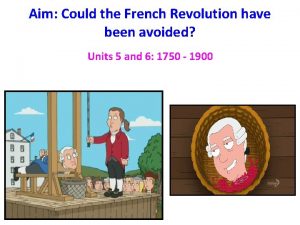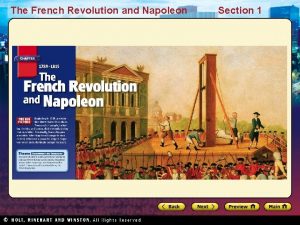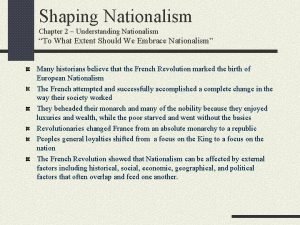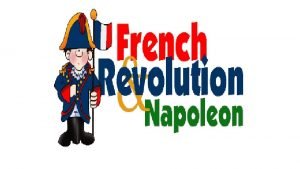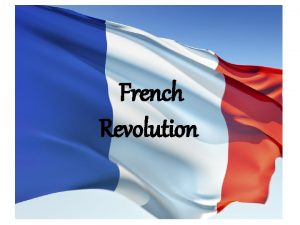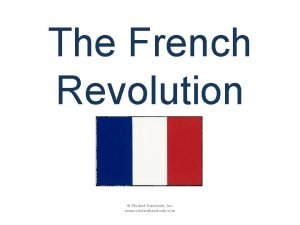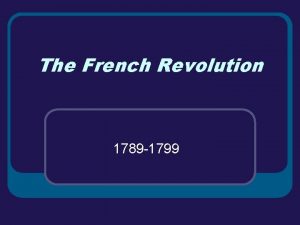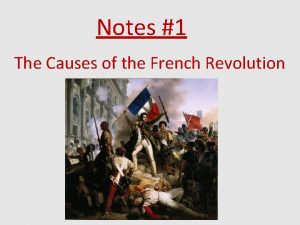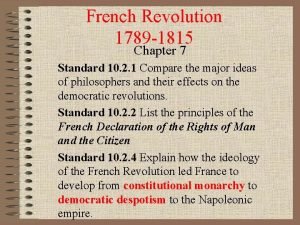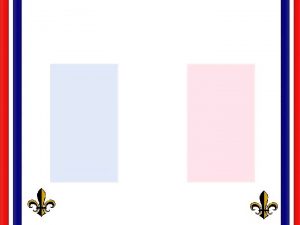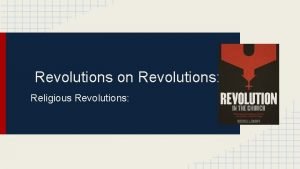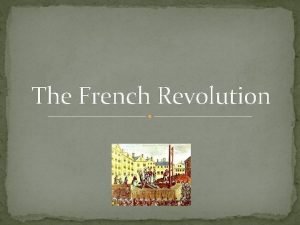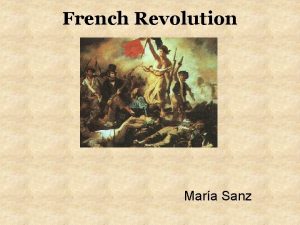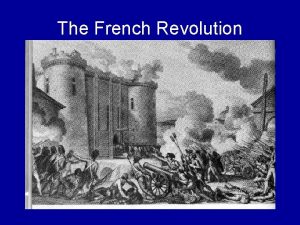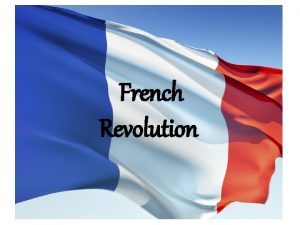THE FRENCH REVOLUTIONS CAUSES OF THE FRENCH REVOLUTION











- Slides: 11

THE FRENCH REVOLUTIONS

CAUSES OF THE FRENCH REVOLUTION • • A social and political structure called the Old Order, or the ancient regime, created inequalities in French society – called the Three Estates with the King at the top. • First Estate: Clergy, owned 10% of the land, paid little or no taxes • Second Estate: Nobles, dependent upon the king for jobs, paid no taxes. • Third Estate: 98% of the French population – Bourgeoisie (Middle Class) and Peasants. The Third Estate resented the privileges enjoyed by the Second and First Estates. • Bourgeoisie were wealthy but could not enjoy the best jobs reserved for nobles. • • Peasants paid too many taxes and had very low wages. Members of the Third Estate were inspired by ideas of the Enlightenment as well as the American Revolution and the constitutional monarchy of Great Britain. Spending of Louis XIV during French and Indian War, support of the American Revolution, and the king’s lifestyle left France in a lot of debt. • First and Second Estate forced to start paying taxes. Bad harvests and cold weather left the peasants cold and starving. • Peasants began rioting over bread.

CAUSES OF THE FRENCH REVOLUTION • The First and Second Estate called for the king to summon the Estates General or a group of representatives from each estate that would advise the king. • Louis requested each estate prepare Cahiers or notebooks listing their grievances such as: fairer taxes, freedom of the press, regular meetings of the Estates General, denouncing regulations on leather making shoes too expensive, and the right to kill animals that were destroying their crops. • The Second Estate wanted to bring the monarch under the control of the Estates General. • The Third Estate wanted to change the voting process – in the past each estate only got one vote – they wanted the votes to be counted by the number of representatives. • The Third Estate claimed they represented the people of France and called themselves the National Assembly. • The National Assembly was locked out of the Estates General meeting and instead met across the street at an indoor tennis court and took the Tennis Court Oath in which they vowed to never separate and continue meeting until they established a constitution.

STORMING THE BASTILLE • Louis XIV ordered troops to Paris and Versailles in case the monarchy needed to be preserved by force, but the Third Estate worried that the troops would be used to keep them from meeting. • The people of Paris sought to arm themselves against the King so they went to the Bastille, an ancient prison that traditionally held prisoners who spoke out against the monarchy, looking for weapons. • The commander of the Bastille refused to open the doors before firing on the crowd. • The Parisians broke into the Bastille, killed the commander and some guards, released the prisoners, but found no weapons. • The storming of the Bastille became a symbol of the French Revolution because it was seen as a blow to tyranny and is still celebrated on July 14 th, Bastille Day.

FOUR PHASES OF THE FRENCH REVOLUTION: 1789– 1791 1793– 1794 National Assembly National Convention Constitutional Monarchy The Directory 1792– 1793– 1794

THE NATIONAL ASSEMBLY • After the fall of the Bastille, many people were shocked by what they had done and feared that the king would punish them to end the Revolution. • • By 1789 the National Assembly had eliminated all the feudal dues and services that the peasants owed the landowners as well as the First Estate’s legal privileges. • • There were rumors that the king would attack villages and seize the peasants crops which set off the Great Fear. They adopted the Declaration of the Rights of Man and of the Citizen, a Bill of Rights. • Liberty, equality, and fraternity [brotherhood] • Argued that all men were created equal and are equal before the law. In October thousands of women marched from Paris to Versailles protesting the price of bread. • Most of the protests were aimed at Queen Marie Antoinette for her frivolous lifestyle at the expense of the peasants. • Demanded the King and his family move back to Paris – they did.

CONSTITUTIONAL MONARCHY • The Assembly disbanded the clergy and sold off church lands to pay France’s debts. • In 1791 the National Assembly finished its constitution: • Set up a Legislative Assembly that had power to make laws, collect taxes, and decide issues of war and peace. • Lawmakers would be elected by tax-paying male citizens • Kept the monarchy but severely restricted its power. • To the reformers the constitution reflected the goals of the Enlightenment, end of church interference, and gave power to the people. • Following the completion of the constitution the King and Queen attempted to flee Paris but were brought back to Paris. • Other European rulers warned against harming the King and Queen. • Austria and Prussia sent troops so the National Assembly declared war, but the French troops were quickly defeated.

THE NATIONAL CONVENTION • The National Assembly voted itself out of existence and called for a new legislature, the National Convention. • The National Convention was broken into factions: • The Sans Culottes that pushed for radical action and advocated for the formation of a republic. • The Mountain, or the Montagnards, that belonged to the radical group the Jacobins, represented the interests of the lower middle class and poor. • The Girondins were moderates and supported a constitutional monarchy. • The Plain was made up of swing voters that generally supported the Girondins but later switched to the Mountains. • The King was placed on trial and sentences to death by guillotine.

• • • The National Convention set up the Committee of Public Safety to manage the country’s military defense against the foreign forces on France’s borders. • The committee drafted all able-bodied unmarried men between 18 and 45 for military service. • The Committee of Public Safety was led by Maximillian Robespierre The Convention also set up a court system to eliminate people who threatened the revolution. • Revolutionary leaders feared that they would lose control of the Revolution and so they began a revolution against the government that was set up by a revolution. • The series of accusations, trials, and executions carried out by the convention and Robespierre became known as the Reign of Terror. Robespierre declared that terror was the only way to defend the government against the enemies of the republic.

THE NATIONAL CONVENTION AND DIRECTORY The Revolutionary courts conducted trials in which 17, 000 people were killed anyone accused or associated with the Old Order was sentenced to death. Many of the people executed were the peasants and laborers – the same group the Revolution was supposed to protect. Even Robespierre and his followers were sentenced to death. When the Reign of Terror ended the National Convention wrote another constitution that restricted voting rights of the first constitution. Only men who owned property could win. The new constitution set up The Directory, a government headed by five men called directors. The Directors passed financial reforms that helped farmers but were overall corrupt. They argued amongst themselves causing them to be weak and corrupt.

STORYBOARDTHAT. COM/CLASSROOM • Enter a username and password. • Click “I accept” • Teacher Name: Ms. North • Access code: our 56 • Your group members names: _____ __ • Choose 1 • Enlightenment Salon • American Revolution • Causes of the French Revolution • The French Revolution • Make a 6 -8 panel comic strip for each of your events < • You must have at least 4 speakers in your comic strip
 How the french revolution could have been avoided
How the french revolution could have been avoided The causes of the french revolution
The causes of the french revolution French revolution
French revolution French revolution causes
French revolution causes Causes and effects of the french revolution
Causes and effects of the french revolution The causes of the french revolution
The causes of the french revolution Short term causes of the french revolution
Short term causes of the french revolution How could the french revolution been avoided
How could the french revolution been avoided Storming of the bastille cartoon
Storming of the bastille cartoon The french revolution
The french revolution Committee of public safety
Committee of public safety French revolution
French revolution
